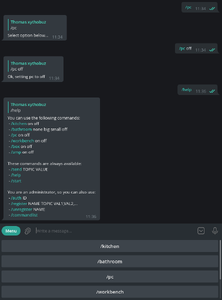MQTT Telegram Bot
Go server to control stuff from anywhere in the world
Project published on August 23, 2022....back to Smart Home overview
After creating my MQTT Web UI I had some troubles getting it to work on all devices. My server at home is using a self-signed SSL certificate. I imported the certificate authority into my desktop, which Chromium accepts fine there. But on Android the connection is still considered insecure, even with the CA cert imported, so the JS can not communicate with the MQTT broker.
To work around that problem I decided to create a simple Telegram Bot that can fulfill the same task of switching the lights.
You can find the source code on Codeberg, as well as installation and setup instructions.
This was my first time doing something with Go. I think the language is interesting and I will probably continue using it in the future. On one hand it was quite easy to find some suitable libraries that simplified the main tasks of the application greatly! But also the language features I found out about impressed me.
One good example is reading the config file. You can simply define a struct that holds all configuration variables, with additional markup to control how it is marshalled and unmarshalled into different formats, in my case yaml.
type Mqtt struct {
Url string `yaml:"url"`
User string `yaml:"username"`
Pass string `yaml:"password"`
}
type Registration struct {
Name string `yaml:"name"`
Topic string `yaml:"topic"`
Values []string `yaml:"values"`
}
type Config struct {
// Telegram Bot API key
Key string `yaml:"api_key"`
// Telegram UserID (int64) of admin account
Admin int64 `yaml:"admin_id"`
// MQTT credentials
Mqtt Mqtt
// Telegram UserIDs (int64) of allowed users
// (does not need to be modified manually)
Users []int64 `yaml:"authorized_users"`
// Available MQTT topics
// (does not need to be modified manually)
Registration []Registration
}
// default values
var config = Config {
Key: "API_KEY_GOES_HERE",
Admin: 0,
Mqtt: Mqtt {
Url: "wss://MQTT_HOST:MQTT_PORT",
User: "MQTT_USERNAME",
Pass: "MQTT_PASSWORD",
},
}
Using simple functions to read and write files according to this format, you can then get a file looking something like this.
api_key: API_KEY_REDACTED
admin_id: ADMIN_ID_REDACTED
mqtt:
url: wss://iot.fritz.box:8083
username: USERNAME_REDACTED
password: PASSWORD_REDACTED
authorized_users: []
registration:
- name: kitchen
topic: livingroom/light_kitchen
values:
- "on"
- "off"
- name: bathroom
topic: bathroom/force_light
values:
- none
- big
- small
- "off"
- name: pc
topic: livingroom/light_pc
values:
- "on"
- "off"
- name: workbench
topic: livingroom/light_bench
values:
- "on"
- "off"
- name: box
topic: livingroom/light_box
values:
- "on"
- "off"
- name: amp
topic: livingroom/light_amp
values:
- "on"
- "off"
I'm using this file both to store static configuration data, like the API key, as well as runtime configuration data entered by the admin user, like available MQTT topics.
All in all I was able to implement a basic working prototype in less than 500 LOC and in just a single evening!

